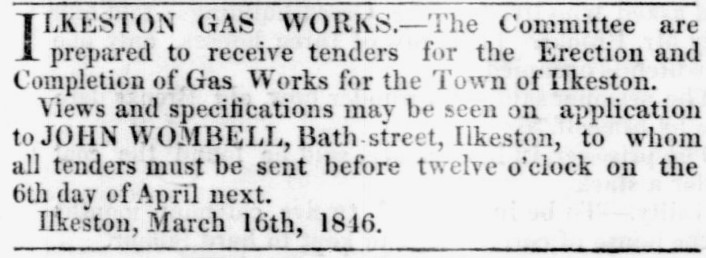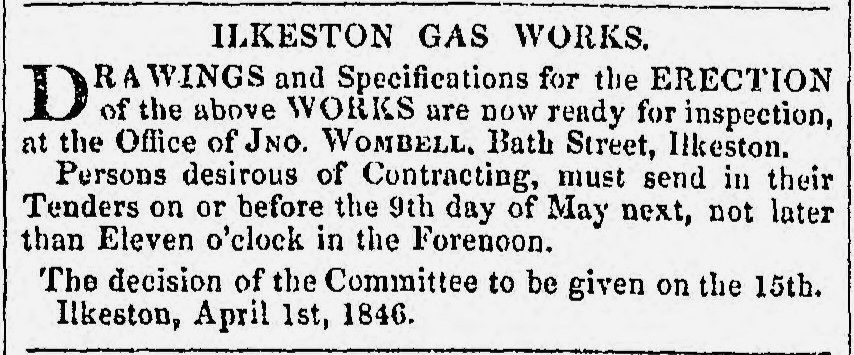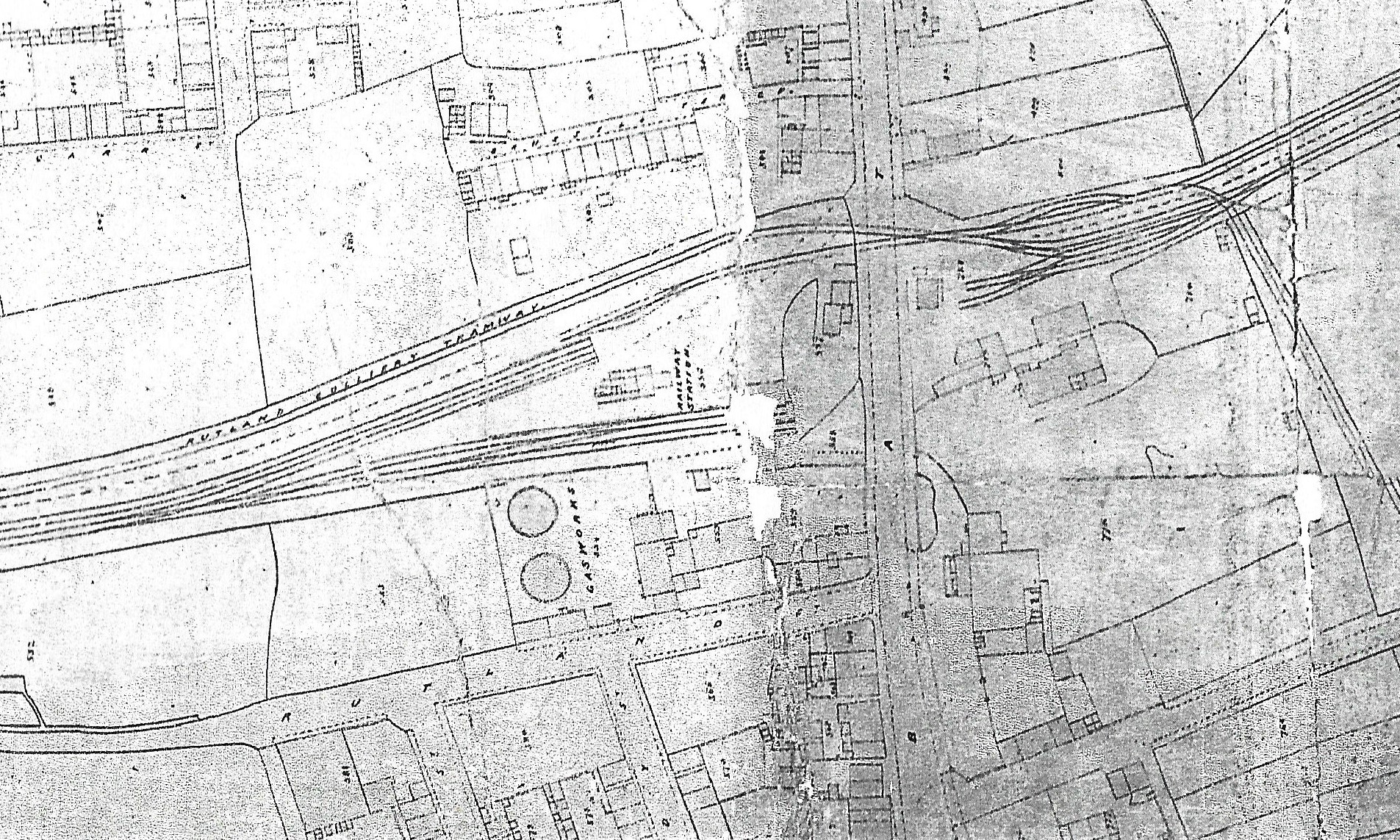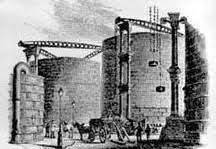As Adeline tells us “in 1857 Ilkeston streets were lighted by gas, but houses and shops were still lighted by candles” (many by courtesy of Moses Mason). However it was several years prior to 1857 that the issue of street lighting had been raised in the town. In October 1845 the large room at the Sir John Warren Inn in the Market Place, was booked for a public meeting to be held, It was chaired by Dr George Lucas, and Henry Carrier senior was the first to put forward a resolution — “that the town should be lighted with gas“. He was supported by Joseph Bailey who proposed a second resolution — since there were two gas companies interested in the scheme, Joseph proposed that they should be amalgamated to unite the two interests. At the meeting general agreement was expressed that it was time for Ilkeston to adopt gas. It was further agreed that the two prospective gas companies should meet and “sort out terms of agreement“. Here I am tempted to sneer cynically, but the two companies did, in fact, meet as proposed, and did amalgamate into one company. A provisional committee of about 40 “respectable inhabitants” to discuss the allotment of shares in this new company was set up and met for the first time on December 26th, 1845. The new company was to be called the Ilkeston Gas Light Company.
The Ilkeston Gas-Light and Coke Company (formed in 1846)
Plans for the gas works at Ilkeston were drawn up at the beginning of 1846 and tenders for their erection were first sought in the spring of that year. For example, a notice (dated March 16th) appeared in the local press asking for tenders for the erection and completion of Gas Works in the ‘town of Ilkeston’. John Wombell, printer of Bath Street, had copies of the plans and specification for interested parties to view, and he was the one ready to receive any tenders. The closing date for applications was April 6th, at mid-day.
…. followed by …
In May, 1846, the tenders of James Goddard of Ilkeston and Thomas Crump of Derby to build the works were chosen by the Gas Company’s committee, while Messrs Mellington and Wade were other craftsmen employed. Building of the works in Rutland Street seems to have begun shortly after this when the Nottinghamshire Guardian (August 7th, 1846) reported that “a new Gas-house and appendages are in course of erection at the bottom of Bath-street which will be completed in a few months“. This was followed by a progress report (Nottinghamshire Guardian, September 18th) that the works were “rapidly going on towards completion” and at the end of October the Nottingham Review was confidently stating that pipes were being laid and the people of Ilkeston village will very shortly have their streets and shops illuminated with gas. This was followed by a letter in the Derby Mercury of December, 1846 lamenting the fact that on Sunday of all days men can be heard labouring at the gas works “which are now in erection (at) Ilkestone”. And on December 15th fires were lit in the Gas Works for the first time. The Nottingham Mercury and General Advertiser announced that “the inhabitants expect their town to be lighted with gas for the first time in September next” (i.e. 1847).
1847-1857: Let there be light.
In 1847 the company issued 400 shares of £5 each but this proved insufficient and further capital of £500 was raised in 1848.
The Nottingham Review of September 1848 reported the second Ordinary General Meeting of the company’s shareholders at “the house of Mr. Bennett in East Street” — that is the Wine Vaults of William Bennett. George Blake Norman was in the chair and Matthew Hobson and ‘Mr Carrier’ were re-elected as directors.
Much later, when the Ilkeston Gas Provisional Order Bill came before a Select Committee of the House of Lords in 1877 it was stated that the Ilkeston Gaslight and Coke Company was established by deed of settlement in 1848, but without any Parliamentary sanction, as was the case with hundreds of gas companies throughout the country. This basically meant that it was unregulated, as to price, quality of gas, amount of share dividend, the keeping and annual publication of accounts, and other matters.
The question to be now answered was who was to pay for this lighting. In a letter to the Nottingham Mercury, dated March 1st, 1848, John Barker (of the Bridge Inn in Awsworth Road ?) casts some light on this issue. He indicated that a parish rate had been agreed at the last Vestry meeting, though it was payable only by those who benefitted from the lighting. It was not to extend more that 100 yards beyond the furthest lamp-post. John was one of the Gas Inspectors appointed to oversee the rate collection while the Assistant Overseer was to make out the rate, mark off which parts of the parish were to pay it and collect it. This interpretation of the regulations was not universally accepted however, as others pointed out that payment had been extended to the whole parish. And this argument was fostered by the fact that the record of the meeting where the issue had been discussed was ‘very difficut‘ to find !!
Consequently another meeting of the rate-payers was called for June 2nd and it subsequently met at the Town Hall aka the Church schoolroom in the Market Place. This was another acrimonious gathering at which the “lighters” (those wishing to take advantage of the gas lamps now available within some parts of the town) outnumbered and out-voted the “non-lighters“. And when the decision was clearly going against the latter group, most of them stormed out of the hall. As a result, the churchwarden allotted £120 to finance lighting for the next year … and new lighting inspectors were appointed. One of their first acts was to place gas lamps in Chapel Street, Pimlico and Albion Place (September 1848)
By 1850 the ‘principal parts of the town’ were now lit by voluntary contributions, the inhabitants preferring donations to darkness.
In 1853 the Pioneer reported that “it appears that most of the difficulties which have hitherto impeded the success of the gas company have been surmounted, and that, for the first time in its history, it is enabled to realise something like a respectable dividend, viz., 7s on each £6 5s share”.
In 1856 the total share capital of the Company was increased to £3,448.
White’s Directory of 1857 gives 1848 as the year of erection of the Gas Works costing £2,500 and financed by the issue of 400 shares of £6 5s each.
The same directory also informs us that “the present gasholder will contain 12,000 cubic feet of gas, but is too small for the consumption; it is therefore intended to put up another to hold about 14,000 cubic feet, and otherwise enlarge and improve the premises at an out lay of £500”.
The first gasworks were situated on the south side of Rutland Street and separated from Bath Street by other industrial premises. At this time Bartholomew Wilson was the Company Secretary. Later the new larger gasworks were built, further down and on the opposite side of the same street, between Bloomsgrove Road and Belfield Street.
The map, above, is taken from the Local Board map of 1866. You will see that serious damage to the original, down its centre, has marred its clarity. As the mapmaker marked his features in a ‘contrary’ direction, I have reversed the map to show the south at the top.
Hopefully you will identify the two circular gas-holders on the south side of Rutland Street.
Just above them, right, is named the Railway Station.
Also named are Brussels Terrace, Carr St., and Bath Street (partially), the latter running south to north
————————————————————————————————————————————————
We must now introduce the Local Board and examine what it was, what role it played in the development of gas provision in Ilkeston, and what part it played in other aspects of town life. In the process we will be introduced to several prominent Ilkeston personalities many of whom we shall meet again as we continue our walk.





